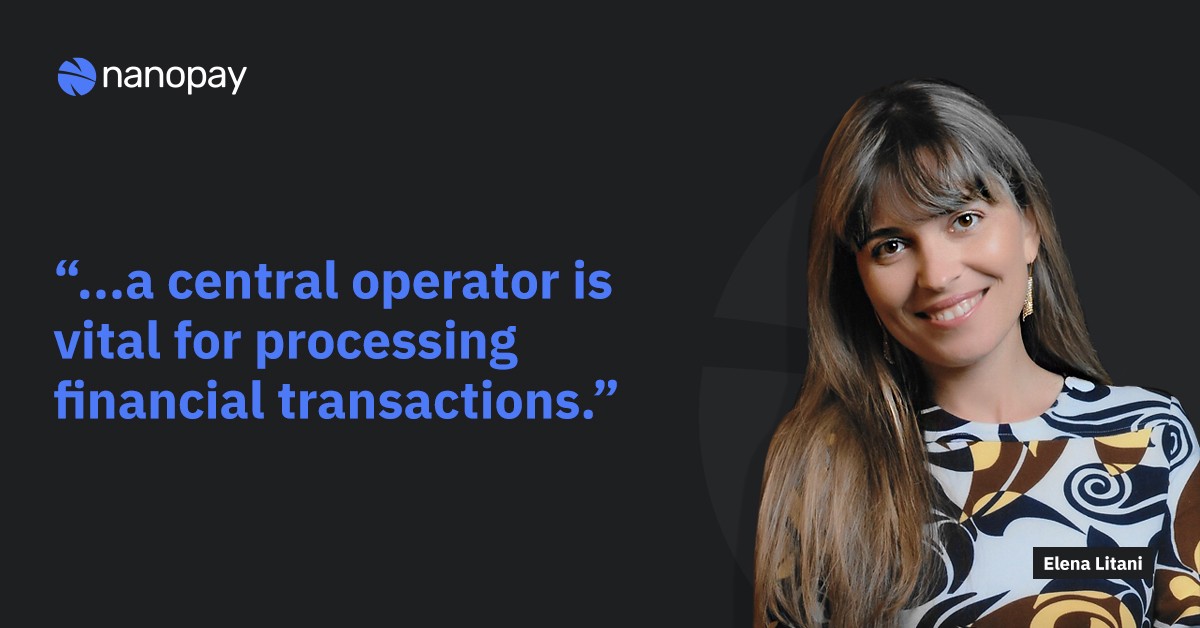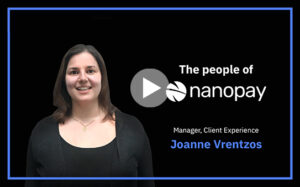Introduction
On first impression, Elena Litani, nanopay’s Director, Banking and Capital Markets Solutions appears unassuming, but she is not to be underestimated. Spending much of her career working on applications for emerging technologies, Elena is a specialist in blockchain and Distributed Ledger Technology (DLT). Having worked on numerous innovation projects at both IBM and TD bank, she is considered a leader in this contentious space.
I had the pleasure of sitting down with Elena to talk about her journey and why an expert in distributed ledger technology has come to work at nanopay, a company that uses a centralized ledger at the foundation of their products.
Q: You have an interesting background, having worked in blockchain at two large organizations long before blockchain was in the spotlight. Can you tell me more about that path and what brought you to nanopay?
Elena: I started my career at IBM and was fortunate be able to pursue many exciting opportunities. I worked on emerging technologies and open source projects, defined industry standards, built new products and worked with global clients to drive an innovation agenda. My passion for new technologies and new ideas drove me to blockchain. I spent almost a year working with the first clients to apply this technology. Eventually, I felt that I needed more insight into financial use cases hence I made a decision to leave IBM and join TD Bank.
At TD, I led a startup-like technology team, experimenting with permissioned blockchains and distributed ledger technology (DLT);applying it for financial services use cases. It was amazing to be part of global initiatives such as Project Jasper (Bank of Canada, Payments Canada), Nostro reconciliation (SWIFT), Digital ID in Canada (SecureKey) and many more. While my time at TD allowed me to pursue some future facing applications of this technology, many of our pursuits never got to see the light of day.
Why nanopay? Because I wanted to focus on payments, and at nanopay, not only can I apply blockchain-inspired technology and pursue innovation within payments, but I can also be fast-paced in delivering new generation payment products to market. This is like a dream come true!
Q: So what separated nanopay from other fintech startups?
Elena: I was captivated by nanopay’s vision — to enable frictionless payments. It is exciting to be part of a company that is looking to define the future where all payments are digital and in real time. The real-time movement of funds will impact almost every type of financial transaction today.
In addition, the company is agile, forward-looking, and moving extremely fast from concept to Minimal Viable Product (MVP) to acquiring our first customers. Continuously working to identify new market opportunities, pivoting if necessary, executing with excellence — this is what I love about the startup life.
Q: When people say “blockchain” there are many different definitions. You mentioned permissioned blockchains and distributed ledger technologies (DLT), can you explain what these are?
Elena: Let’s start with a simple introduction to blockchain. Blockchain is a type of data structure (e.g. database) that enables a secure transaction ledger with automatic reconciliation. In its purest form, this data structure is a chain of blocks and each block has a set number of transactions. The blockchain approach is specifically designed to eliminate a central control: no central operator or administrator of the system is required. The first application of blockchain is Bitcoin.
Now, Bitcoin and Ethereum could not easily address enterprise requirements such as, confidentiality, privacy, or high transactions per second. Therefore, original (public) blockchains had to be modified, and blockchains for enterprises started to emerge. Some are preserving the chain of blocks structure and are often referred to as permissioned blockchains. Others, do not require blocks, but provide other mechanisms to link transactions and these are often called distributed ledger technologies (DLT). Examples include, Corda (R3), Hyperledger Fabric, and Quorum (JP Morgan).
Q: So is nanopay technology another permissioned blockchain? Can you explain where the company’s use of blockchain starts and stops?
Elena: For simplicity, I would classify nanopay technology as blockchain-inspired. Similarly to permissioned blockchains or DLTs, nanopay’s platform stores and communicates data, with built-in redundancy and protection from loss. The data is reconciled automatically while ensuring privacy and confidentiality. The data is also secured using the same building blocks as DLT: public key cryptography, hash functions and transaction linking.
However, there is one major difference — while blockchains are specifically designed to prevent central governance, nanopay believes a central operator is vital for processing financial transactions.
This is what makes us unique — while we provide blockchain-grade ledger security, nanopay’s principles of privacy, confidentiality, segregation of funds, and centralization, makes it much easier for financial service providers to adopt our platform and allows us to achieve very high transaction throughput.
Q: Can you elaborate more on the advantages of using nanopay technology specifically for payments?
Elena: In the first couple of years working with blockchain, I was optimistic of its potential to address payment use cases. Unfortunately, most enterprise blockchain payment initiatives could not achieve full decentralization. Instead, usually a centralized organization was created or assigned to establish standards, enforce governance and operate the network. This begs the question — if decentralization can’t be achieved for payments, do you need blockchain or some other type of technology to solve the problem (e.g. distributed database)?
This is why nanopay’s approach is better. With centralization, not only is it easier to govern and support (eliminating costly and complex distributed updates), but it also makes it easier to adhere to current regulatory regime and privacy regulations (that limit an ability to record even encrypted data on blockchain/DLT).
Q: In addition to payments, one area nanopay is focused on is cash and liquidity management. Can you expand on how nanopay’s technology can help for treasury use cases?
Elena: Cash and liquidity management is another area ripe for change. Since 2008, treasury has gone through dramatic transformations, resulting in major impacts on cash and liquidity management. Regulatory changes, technological advancements (e.g. robotic automation), real-time rails, and globalization are all contributing factors to enable real-time treasury.
nanopay is building a next generation solution for treasury that brings a combination of virtual account and virtual ledger management. Not only does this enable automation of liquidity management, but also gives global corporations a view of their real-time liquidity position across the multinational entity, enabling them to alleviate trapped capital, eliminate credit exposure and take advantage of investment opportunities. This is a fast evolving space I recommend you watch for.
Q: With an impressive background in both finance and tech, do you have any advice to the next generation just entering the workforce today?
Elena: Do not let stereotypes hold you back! Continuously improve your skills, ask for and create new opportunities. Surround yourself with people who approach life with passion, enthusiasm and professionalism. Let them be your own “board of directors!”. Be bold and be brave!





